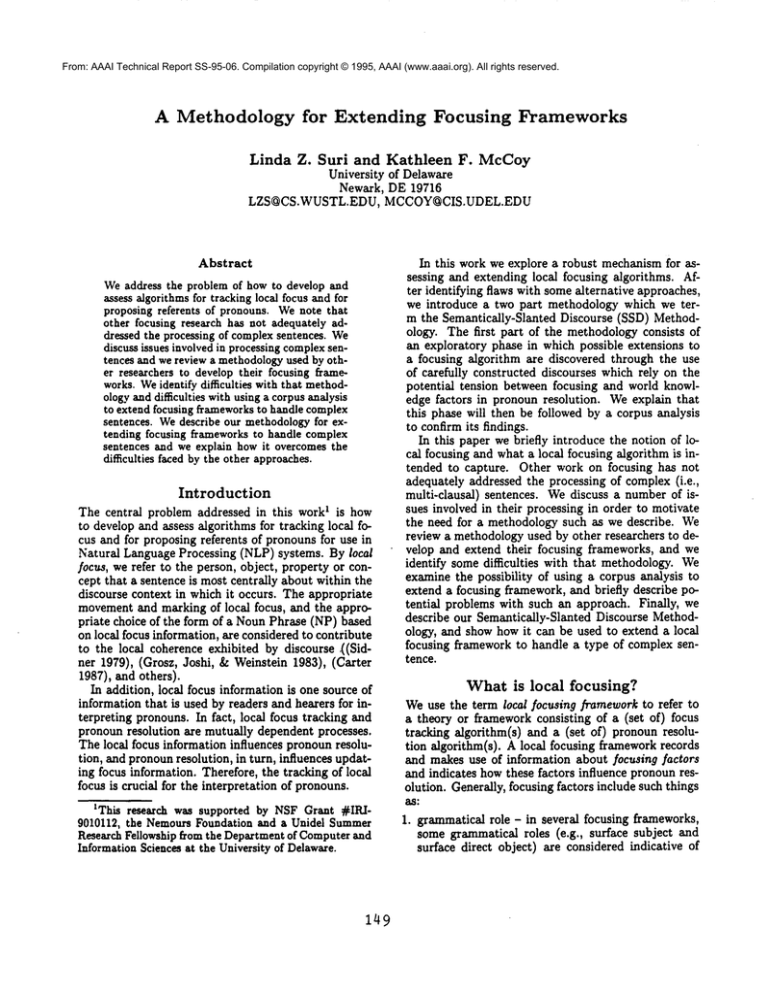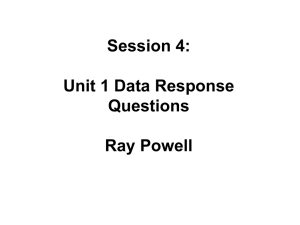A Methodology for Extending Focusing Frameworks
advertisement

From: AAAI Technical Report SS-95-06. Compilation copyright © 1995, AAAI (www.aaai.org). All rights reserved. A Methodology Linda for Extending Z. Suri and University Newark, LZS@CS.WUSTL.EDU, Abstract Weaddress the problem of how to develop and assess algorithmsfor tracking local focus and for proposing referents of pronouns. Wenote that other focusing research has not adequately addressed the processing of complexsentences. We discuss issues involved in processingcomplexsentences and we review a methodologyused by other researchers to develop their focusing frameworks. Weidentify di~culties with that methodologyand dit~iculties with using a corpusanalysis to extend focusing frameworksto handle complex sentences. Wedescribe our methodologyfor extending focusing frameworksto handle complex sentences and we explain how it overcomesthe difficulties faced by the other approaches. Introduction The central problem addressed in this workI is how to develop and assess algorithms for tracking local focus and for proposing referents of pronouns for use in Natural Language Processing (NLP) systems. By local focus, we refer to the person, object, property or concept that a sentence is most centrally about within the discourse context in which it occurs. The appropriate movementand marking of local focus, and the appropriate choice of the form of a NounPhrase (NP) based on local focus information, are considered to contribute to the local coherence exhibited by discourse ,((Sidner 1979), (Grosz, Joshi, & Weinstein 1983), (Carter 1987), and others). In addition, local focus information is one source of information that is used by readers and hearers for interpreting pronouns. In fact, local focus tracking and pronoun resolution are mutually dependent processes. The local focus information influences pronoun resolution, and pronounresolution, in turn, influences updating focus information. Therefore, the tracking of local focus is crucial for the interpretation of pronouns. 1This research was supported by NSF Grant #IRI9010112, the Nemours Foundation and a Unidel Summer Research Fellowship from the Departmentof Computerand Information Sciences at the University of Delaware. 149 Focusing Frameworks Kathleen F. McCoy of Delaware DE 19716 MCCOY@CIS.UDEL.EDU In this work we explore a robust mechanismfor assessing and extending local focusing algorithms. After identifying flaws with some alternative approaches, we introduce a two part methodology which we term the Semantically-Slanted Discourse (SSD) Methodology. The first part of the methodology consists of an exploratory phase in which possible extensions to a focusing algorithm are discovered through the use of carefully constructed discourses which rely on the potential tension between focusing and world knowledge factors in pronoun resolution. Weexplain that this phase will then be followed by a corpus analysis to confirm its findings. In this paper we briefly introduce the notion of local focusing and what a local focusing algorithm is intended to capture. Other work on focusing has not adequately addressed the processing of complex (i.e., multi-clausal) sentences. Wediscuss a number of issues involved in their processing in order to motivate the need for a methodology such as we describe. We review a methodologyused by other researchers to develop and extend their focusing frameworks, and we identify some difficulties with that methodology. We examine the possibility of using a corpus analysis to extend a focusing framework, and briefly describe potential problems with such an approach. Finally, we describe our Semantically-Slanted Discourse Methodology, and show how it can be used to extend a local focusing framework to handle a type of complex sentence. What is local focusing? Weuse the term local focusing framework to refer to a theory or framework consisting of a (set of) focus tracking algorithm(s) and a (set of) pronoun resolution algorithm(s). A local focusing frameworkrecords and makes use of information about focusing factors and indicates howthese factors influence pronoun resolution. Generally, focusing factors include such things as: 1. grammatical role - in several focusing frameworks, some grammatical roles (e.g., surface subject and surface direct object) are considered indicative of what is in focus. Also, a pronoun resolution algorithm might prefer to find an antecedent which has the same grammatical role as the pronoun. 2. pronoun use - most, if not all, focusing frameworks are constructed on the basis of the belief that pronominalization is often indicative of focus. 3. constancy of focus - manyfocusing frameworks assume that if an item that was the focus of the previous sentence occurs in the current sentence, it is more likely to be focused in the current sentence. 4. clue words and phrases - most, if not all, focusing research takes into consideration that clue words and phrases might affect pronoun resolution and what is focused in a sentence. 5. syntactic form - in some frameworks, certain syntactic forms (e.g., clefted sentences) might indicate an item as highly focused. The specific list of focusing factors and the way they interact are different for different focusing frameworks. A particular focusing frameworkmust identify a set of focusing factors and must indicate how these focusing factors interact to suggest co-specifications for pronoun resolution and to identify the focus of a sentence. A local focusing frameworkis not intended to independently interpret pronouns. Rather, a local focusing frameworkis intended to suggest co-specifications for pronouns in a reasonable order. An inferencing mechanism that makes use of semantic ]actors (such as semantic case constraints, world knowledge, rhetorical relations, etc.) must be used to confirm or reject suggested co-specification. Thus, local focusing frameworks are intended to capture a coherence factor in discourse which influences preferences for how to resolve pronouns independent of semantic factors. Processing Complex Sentences: A Reason for Extending Focusing Algorithms Although complex sentences are prevalent in written English, other local focusing research (Focusing: (Sidnet 1979), (Carter 1987); centering: (Grosz, Joshi, & Weinstein 1983), (Brennan, Friedman, & Pollard 1987), (Walker 1989), (Kameyama1986), (Walker, da, & Cote 1992), (Brennan 1993), (Kameyama1993), (Kameyama, Passonnean, & Poesio 1993), (Linson 1993), (Hoffman & Turan 1993), (Walker 1993); PUNDIT:(Dahl 1986), (Palmer et al. 1986), (Dahl Ball 1990)) did not explicitly and/or adequately address how to process complex sentences. Thus, there is a need to extend focusing algorithms. Notice that there are a numberof ways that a given type of complex sentence might be handled. For instance, consider processing a complex sentence of the form "SX because SY," where SX and SY each consist of a single clause. One might imagine processing the SXclause and then the SY clause (i.e., resolving 15o the pronouns in these clauses and updating the focusing data structures) as if the clauses were a sequence of simple (i.e., single clause) sentences. On the other hand, it may be the case that for this type of complex sentence, the sentence should be treated as a single unit of processing with elements of one of the clauses dominating the processing. (For further discussion of these and other possible processing possibilities, see (Suri 1993).) The question we address is how one can appropriately extend a focusing mechanism to handle various kinds of complex sentences? A Methodology Used in Other Local Focusing Work Recall that local focusing theories are attempting to capture patterns of focus movement and patterns of relations between anaphors and their antecedents that are independent of semantics, world knowledge, rhetorical relations, etc. Because of this, the method for ’determining how to process particular kinds of complex sentences that might seem the most natural is to construct semantically-neutral discourses 3 that involve the type of complex sentence under study, and gather linguistic judgments to determine how people prefer to resolve the pronouns. In fact, in exploring other aspects of local focusing frameworks, other literature appears to have tried to make use of semantically-neutral texts in this fashion (e.g., (Brennan, Friedman, & Pollard 1987), (Walker, Iida, &Cote 1992)). However,in trying to construct discourses to determine howto process a particular kind of complex sentence, we realized it is difficult to construct discourses that are truly semantically-neutral and sound natural. This task is further complicated by the need to construct a numberof semantically-neutral texts in order to control for and isolate each of the factors that might affect how readers prefer to resolve pronouns.4 These factors include the influence of the other complex sentence structures in the discourse, and the factors that affect focus computation and pronoun resolution for simple sentences, i.e., focus history, the syntactic roles of pronouns and their potential antecedents, verb aspect and tense, etc. More importantly, when one is constructing texts without the benefit of a systematic methodology, one cannot be sure that the collection of constructed texts are representative of naturally-occurring text in terms of the interactive relationships within and across focusing and semantic factors, and their influence on pro2Note,it is possible that various types of complexsentences wouldeach need to be handled differently. 3I.e., discourses whose pronouns cannot be unambiguously resolved on the basis of semantic/world knowledge factors alone. 4This need was not addressed by previous focusing work in an adequate or systematic fashion. nouninterpretation. As a result, thereis a danger of tuninga theoryto handlea discourse phenomena that is theexception ratherthenthenormin naturallyoccurring situations. Using a Corpus Analysisto Extend Frameworks Becauseof the problems associated withusingconstructed discourses, itis natural to turnto somekind of corpusanalysis to extenda focusing framework. For example, one mightmeasure how wellan extension of a framework handlesa typeof complexsentenceby measuring howaccurately andefficiently it suggests referents forpronouns in textswhichcontain thetype of complexsentence underconsideration. One could counthow oftenthe extendedframework suggestsa wrongreferent (which wouldnotbe rejected by an ideal inferencing mechanism), andhowmanyreferents it suggests (onaverage) totheinferencing component beforethecorrect referent isselected. In usingthistypeof approach, oneis facedwith several potential difficulties. First, a focusing frameworkis intended to capture a reader’s preferences for focusmovementand pronounresolution independent of worldknowledge, semantics, andotherpragmatic factors. Verylargeamounts of textwouldhaveto be analyzed tocontrol theinfluence ofthesefactors, yet, since there arefewtools available forthistypeofanalysis,thistaskwouldbe formidable. Second, a corpus analysis maybe useful in comparing various extensions, butitisupto thedesigner todecide whichextensions to compare. Usingthisapproach, a novelextension cannotemergeby becoming evident as a sideeffect oftheanalysis. Generally speaking, before a corpus analysis canbe used,theresearcher musthave madealldecisions concerning theprocessing. Thatis, allpossible extensions of theframework (whichareto be testedin thecorpusanalysis) mustbe completely identified. Notice, however, thatthereis noguarantee thatthecorrect extension willbe specified andtested. One mightoverlookthe appropriate answersto how to segment sentences andhowto process a particular kindof complexsentence. In addition, the number of possible extensions is likely quite large, and thus the numberof alternative corpus analyses will likely be quite prohibitive. Perhaps the most significant and problematic obstacle for determining how to extend a focusing framework to handle a particular kind of complex sentence via a corpus analysis is the following: if one does not know how to process many types of complex sentences, it is difficult to perform a corpus analysis to determine how to process a given type of complex sentence, since instances of that type of complex sentence are likely to be preceded and followed by other types of complex sentences. Furthermore, manysentences in the corpus axe likely to involve multiple levels of complexity. Thus there is no way to isolate the influence of one complex 151 sentence structure from the effect of another complex sentence structure. Our Two-Part Methodologyfor Determining How to Process Complex Sentences As we havepointed out,thereareseveralpotential problems withanalyses usingconstructed discourses and withcorpusanalyses. Ourmethodology combines specific instances of bothofthesemethodologies; these specific instances weredesigned to overcome thedifficulties weidentified. Thefirstpartof ourmethodology involves systematicallyconstructing discourses (ofa typetobedescribed) and gathering acceptability judgments on these discourses. The discourses are constructed in such a way so as to help identify a plausible extension of a focusing algorithm which would handle the type of complex sentence in question. The resulting extension must then be confirmed by a corpus analysis to ensure that the constructed discourses uncovered influences actually found in naturally-occurring text. In the remainder of this paper, we focus on the constructed discourse portion of our methodology. Werefer the reader to (Suri 1993) for a full description how the methodology was used to extend a particular focusing frameworkto handle sentences of the form "SX because SY," although we summarize our technique and findings here. Semantically-Slanted Discourse (SSD) Methodology In previous literature on localfocusing (e.g., (Sidner 1979),(Grosz,Joshi,& Weinstein 1983),(Brennan, Friedman, & Pollard 1987)), researchers useda small number of constructed textsto justify aspects of their focusing frameworks andto assessandcompare focusingframeworks. However, theydidnotexplicitly addresshowoneshouldconstruct setsof textsin order to drawaccurate conclusions aboutlocalfocusing. The firstpartof ourmethodology is intended to helpthe researcher construct setsof texts (i.e., minimal pairs or minimal quadruples) thatallowcomponents of a focusingframework to be systematically isolated andthus allowoneto appropriately assess focusing frameworks. To appreciate thereasoning behind thefirstpartof ourmethodology, or whatwe callour SemanticallySlanted Discourse (SSD) Methodology, recall that local focusing frameworks(including centering) are intended to capture the preferences for pronoun resolution independent o.f semantics, world knowledge,rhetorical relations and other kinds of pragmatics. Thus, they are intended to capture how one would resolve pronouns and update focusing information in discourse that is neutral in terms of these factors. Presumablyin such texts, only focusing factors would affect pronoun resolution. In a semantically-non-neutral discourse, semantic fac- tors(semantics, worldknowledge, etc.)canoverride thepreferences of thefocusing framework by rejecting potential referents proposed by a focusing framework. Takingthisintoaccount, in orderto determine how bestto process a particular typeof complex sentence, we decided to construct discourses thathavetwoimportant properties: 1.Theset of discourses mustbe systematically constructed to ensurethateachpossible combination offocusing factors is represented in a discourse. We showhowthisis donebelowfora particular focusing framework anda singletypeof complex sentence. areintentionally loadedor slanted 2. Thediscourses for pronoun interpretation basedon semantic factors.Wecall such a discourse semantically-slanted because the interpretation of all of the pronouns is fully determined by the semantic factors alone. Wecontend that in a semantically-slanted discourse, if the text seems ambiguous or awkward, or if one needs to re-interpret a pronoun, then the focusing preferences for pronoun resolution are at odds with the preferences based on semantics, world knowledge, or other pragmatic factors. On the other hand, if the text seems acceptable/natural, then we contend the preferences for pronoun resolution based on focusing agree with preferences based on semantic slanting. Thus, gathering acceptability judgments about these systematically constructed semantically-slanted discourses should help us identify what the focusing preferences are, and thus how a focusing framework should be extended to handle a given type of complex sentence. This is the idea at the heart of our methodology. Isolating the Complexity In usingsemantically-slanted discourses to uncover an extension of a focusing algorithm, we mustfirstmake surethatthediscourses we construct isolate thecomplexity understudy. Thisfactor influences theoverall formof thediscourses beingconstructed. In orderto isolate thecomplexity understudy,we construct discourses of thefollowing form,forwhich theinterpretation of theNPsis fullydetermined by thesemantics of thetextandworldknowledge: Example 1 $1) Simple sentence $2) Sentence with one level of complexity (i.e., having two clauses}, introduced by the syntactic form of interest. $3} Simple sentence In examining linguistic judgments about such texts, our goal is to identify preferences imposed by the syntactic form of $2 for: ¯ resolving pronouns in $2 ¯ updating thefocusing datastructures after$2 so thatthepronouns of $3 canbe correctly resolved in 152 a mannerthatis consistent withresolving pronouns in a sentence following a simplesentence or another kindof complex sentence. Themotivation forhaving $1 be a simple sentence is to avoidanyeffecta complex sentence mighthaveon thefocusing datastructures goinginto$2.Similarly, themotivation forhaving $3 be a simple sentence is to avoidanyeffectthata complex sentence structure in $3 mighthaveon pronoun resolution in $3. Systematic Construction of Discourses for "SX because SY" Sentences Ourmethodology callsforthesystematic construction of a setof discourses thatensures thatallpossible combinations of thefocusing factors arerepresented. Thiswillallowan extension of thefocusing framework to emerge (since thediscourses essentially capture all possibilities foran extension). To seethetypesof discourses ourmethodology callsforconstructing, let us consider whatwouldbe neededto extenda particularfocusing framework, RAFT/RAPR (described in (Suri 1993)), to handle resolving subject pronouns sentences of the form "SX because SY" where SX and SYare simple sentences, and in a sentence following that type of sentence. To address this question, we examined discourses that are "variations" of the form shown in Example 2. Example 2 $1) Dodge was nearly robbed by an ex-convict the other night. $2) [Dodge] captured [the ex-con] because [the ex-con] was so stupid and clumsy. $3) Then [Dodge] called the police. Weneeded to construct variations of this text in order to tease out howthe various focusing factors interact. The RAFT/RAPRalgorithm prefers to resolve a subject pronoun (in a simple sentence) so that it corefers with the subject of the previous sentence if the previous sentence is a simple sentence. The subject of a simple sentence is selected as (the contents of a focusing data structure that we call) the Subject Focus of that sentence. If this suggested referent (i.e., the previous sentence’s Subject Focus) is rejected by inferencing with world knowledge, semantics, and pragmatics, then other elements in the previous discourse are tried in a specified order; this ordering is (indirectly) influenced by such things as whether a pronoun was used in the previous sentence (since pronouns are indicative of focus and therefore influence the focus computation for the previous sentence). Note, the algorithm prefers constancy in Subject Focus over shifting the Subject Focus. Some questions that must be answered in coming up with an extension of RAFT/RAPR in handling "SX because SY" sentences are: i. HowshouldSubject(SY) be resolved? I.e.,should thealgorithm preferthatit co-refers withSubject(S1)or Subject(SX)? 2. HowshouldSubject(S3) be resolved? I.e., ¯ Preferring Subject(SX) always? ¯ Preferring Subject(SY) always? ¯ Preferring Subject(SX) or Subject(SY) depending on whichis pronominalized? ¯ Preferring Subject(SX) or Subject(SY) depending on whichisco-referential withSubject(S1)? ¯ Basedon someotherpreference? Theanswers to these(andallsuchsimilar questions) constitute a decision abouthowandwhether thecomplexsentence shouldbe segmented, andhowto weigh theinfluences of thevarious focusing factors suchas pronominalization andfocushistory in resolving pronounsandin updating thefocusing datastructures. To see howwe makeup the variations to coverall possibilities, consider thisabstract viewofthetext whichindicates theNPswe areinterested in: Example 3 $1) Subject(S1) ... Direct-Object(S1) $2) Subject(SX) ... Direct-Object(SX) because Subject(SY) ... $3) Subject(S3) To find an extension of the focusing algorithm, we need to make up variations of the text which capture all the different ways the grammaticalroles, focus history, and pronominalization (i.e., the focusing factors) might interact in determining the referent of the pronoun in Subject(S3). Wemake up text variations corresponding to variations of the following parameters: 1. Whether Subject(S1) is the ex-convict or Dodge. ("An ex-convict nearly robbed Dodge the other night" vs. "Dodge was nearly robbed by an exconvict the other night.") ¯ Note that the Direct-Object(S1) will always introduce the other actor. This helps test the focusing factor of grammatical role. 2. Whether Subject(SX) of $2 is the ex-convict Dodge. ("[Dodge] captured [the ex-convict] because [the ex-convict] was so stupid and clumsy" vs. "[The ex-convict] woke[Dodge] up because [the ex-convict] was so stupid and clumsy.") ¯ Notice that 1 and 2 together will vary whether or not the Subject(S1)=Subject(SX). ¯ Note if Subject(S1)¢Subject(SX) then DirectObject(S1)=Subject(SX), again testing grammatical role effects. 3. Whether Subject(SY) of $2 is the ex-convict Dodge. ("[The ex-convict] tied [Dodge] up because [the ex-convict] didn’t want any trouble" vs. "[The ex-convict] tied [Dodge] up because [Dodge] wasn’t co-operating.") 153 4. 5. 6. 7. ¯ 1 and 3 taken together alter whether or not Subject(S1)=Subject(SY). ¯ 2 and 3 taken together alter whether or not Subject (SX)=Subject(SY). ¯ Because the focusing algorithm prefers constancy in Subject Focus history, these alternations help us decide whether S1 or SX is more important in resolving pronouns in SY. 5Whether Subject(S3) is the ex-convict or Dodge. ("Then [the ex-convict] was arrested by the police" vs. "Then [Dodge] started screaming for help.") ¯ This parameter (in conjunction with the others) determines whether Subject(S3)=Subject(SX) or Subject(S3)=Subject(SY) or neither (i.e., Subject ($3) =Direct- Object (SY)). ¯ Similar to 3 above, this parameter helps us determine how the NPs in $2 affect the resolution of the pronoun in $3. Whether Subject(SX) was pronominalized. Whether DirectObject(SX) was pronominalized. Whether Subject(SY) was pronominalized. ¯ 5-7 help check how various patterns of pronominalization might affect the processing. By generating texts for all combinations of different values of these parameters, we are able to control for the influence of each focusing factor. Essentially, taken together, the texts capture all different grammatical roles, focus history patterns, and patterns of pronominalization. The result of this procedure is a set of texts which can be presented to native speakers for judgments. The idea is that in texts which are judged to be acceptable, the reader sees no conflicts, so the focusing factors (grammatical role, pronoun history, and focus history) must agree with the semantic slanting. In texts which are judged unacceptable or ambiguous, there must be a conflict between these two sets of factors. Thus, gathering such judgments should identify an extension of the focusing algorithm. On the basis of the resulting judgments, a possible extension of the focusing algorithm can be identified. Finding an Extension Based on Judgments To see how this methodology can be used to find an extension for a focusing framework, let us concentrate on determining how RAFT/RAPR should compute the focusing data structures for an "SX because SY" sentence in order to correctly resolve a subject pronoun in a simple sentence following an "SX because SY"sentence. In considering this question, recall that 5Recall thatwhenSubject(S3) is pronominalized, the referent ofSubject(S3) is determined by thesemantic lanting ofthetext. RAFT/RAPR prefers to resolve a subject pronoun in a simple sentence with the Subject Focus of the previous sentence. Thus, the specific question we need to address is howto compute the Subject Focus of an "SX 6 because SY"sentence. Again,thefactors thatmightdetermine howto computethesubject focusof a sentence are: 1. syntactic form:for example, perhapstheSubject Focusshouldbe computed as Subject(SX) (or, ternately, Subject(SY)) (regardless of other factors). This wouldbe appropriate if readers prefer to resolve the subject of the subsequent sentence so that it cospecifies Subject(SX) (or, alternately Subject(SY)), regardless of other focusing factors. 2. pronominalization: for example, perhaps the Subject Focus should be computed as Subject(SX) or Subject(SY) depending on which is pronominalized, regardless of other factors (unless both or neither are pronominalized). This would be appropriate if readers prefer to resolve the subject of the subsequent sentence on the basis of whether Subject(SX) or the Subject(SY) was pronominalized. 3. focus history: for example, perhaps Subject Focus should be computed as Subject(SX) or Subject(SY) depending on which co-specified the Subject Focus of the sentence preceding the "SXbecause SY" sentence. 4. Perhaps the interaction of two or more of the above factors (syntactic form, pronominalization and focusing history) might influence how the Subject Focus should be computed. of $2 (whichwillbe usedto resolve Subject(S3)) be Subject(SY) sinceSubject(SY) is pronominalized $2, butSubject(SX) is not.The focushistorywould alsofavorthereading in whichSubject(S3) is Dodge (i.e.,co-refers withtheSubject(SY)) sinceDodge theSubjectFocusof $1 and Dodgeoccursin $2 as a subject. Eventhough onlythefactorof syntactic formfavors theinterpretation thatagrees withsemantic slanting, of the33 subjects in ourexperiment, 91%judgedthis discourse as acceptable. Thissupports thehypothesis thatthesyntaxis themostimportant focusing factor andthatit favors resolving a subject in a simple sentencefollowing an "SXbecauseSY"sentence so that thesubject co-specifies Subject(SX). The abovehypothesis is furthersupported by the judgments givenon a seconddiscourse: Example 5 ($1) Dodgewas robbed by an ex-convict the other night. ($2) The ex-convict tied him up because he wasn’t cooperating. ($3) # Then he started screaming for help. Our findings indicate that the syntactic form alone seems to most greatly influence what should be chosen as the Subject Focus of an "SX because SY" sentence. In particular, we found that readers prefer to resolve the subject of a sentence following an "SXbecause SY" sentence so that the subject co-specifies Subject(SX). This indicates that RAFT/RAPR should compute the Subject Focus as Subject(SX). Consider how the following two judged discourses support this conclusion. Example 4 ($1) Dodgewas robbed by an ex-convict the other night. (S~) The ex-convict tied him up because he wasn’t cooperating. ($3) Then he took all the money and ran. Notice that in the discourse in Example 4 the semantic slanting should lead to the interpretation of $3 as "Then [the ex-conflict] took all the moneyand ran." Thus, in this text, the semantic slanting favors resolving Subject(S3) as Subject(SX), and it would favor computing the Subject Focus of $2 to be Subject(SX). However, notice that the pronominalization in the text favors computing the Subject Focus In Example 5, one would expect subjects to judge the discourse to be "awkward" or "ambiguous" if the syntax factor overrides other focusing factors and causes Subject(SX) to be the preferred referent for the subject of the subsequent sentence. This is because the semantic slanting should lead to the interpretation of $3 as "Then [Dodge] started screaming for help," i.e., an interpretation for which Subject(S3)~Subject(SX). In fact, most subjects (90%), did judge the discourse ras awkward or ambiguous, To reiterate, in Example5: ¯ On the basis of on semantic slanting, Subject(S3)=Subject(SY) and Subject(S3)~Subject(SX). ¯ Subject Focus history would favor Subject(SY) for the Subject Focus of $2 since Subject(SY)=Subject(S1) (i.e., the Subject Focus of ¯ Pronominalization would favor Subject(SY) for the Subject Focus of $2 since the referent of Subject (SY) is pronominalized in $2, but Subject(SX) is not. ¯ The discourse was judged awkward or ambiguous. In Example 4, the focus history and pronominalization favor computing the SF(S2) to be Subject(SY), the mantic slanting indicates Subject(S3) is Subject(SX), and the text was judged acceptable. Taken together, these judgments suggest that the reader prefers to resolve Subject(S3) with Subject(SX) regardless of the other focusing factors since this would explain the judgments as follows: In Example 5, the interpretation of Subject(S3) indicated by this focusing preference would be at odds with the interpretation forced by the semantic slanting and the text was eFor other focusing frameworks, we wouldbe concerned with a different specific question. VAsa result we have labeled (S3) with a "#" which traditionally denotes pragmaticill-formedness. 154 judged awkward; in Example 4, the interpretation indicated by this focusing preference would agree with the interpretation forced by the semantic slanting and the text was judged acceptable. Therefore, we conclude that RAFT/RAPRshould compute the Subject Focus of an "SX because SY" sentence to be Subject(SX). Conclusions The notion of local focusing and its influence on pronoun resolution has been found useful in manyaspects of NLP. However, previous work on local focusing has ignored complex sentences even though they are prevalent in naturally-occurring text. The problem that we faced was one of determining a reasonable way to extend a focusing algorithm to handle these sentences. Previous methodology(i.e., using semantically neutral text) was too simplistic and nearly impossible to utilize. A solely corpus-based analysis is impossible because of the variety of a priori decisions that needed to be made and because of the complexity of interaction amongfactors in naturally-occurring discourses. This work presents a methodology that calls for the systematic construction of texts. It relies on the potential tension of semantic factors with focusing factors to identify possible extensions of a focusing framework to account for a particular kind of complex sentence. The methodology has been used to extend a focusing framework to handle one type of complex sentence. Furthermore, as explained in detail in (Suri 1993), this methodologycan also be used to comparelocal focusing frameworks. Thus, this methodologyallows one to study focusing phenomenaand algorithms related to focusing phenomena. References Brennan, S. E.; Friedman, M. W.; and Pollard, C. J. 1987. A centering approach to pronouns. In Proceedings of the 25th Annual Meeting of the Association for Computational Linguistics, 155-162. Brennan, S. E. 1993. Reference and local structure in interactive discourse. In the proceedings of the Workshop on Centering Theory in Naturally-Occurring Discourse, Institute for Research in Cognitive Science, University of Pennsylvania. Carter, D. 1987. Interpreting Anaphors in Natural Language Texts. NewYork: John Wiley and Sons. Dahl, D., and Ball, C. N. 1990. Reference resolution in PUNDIT.Technical Report CAIT-SLS-9004, UNISYS,Paoli, PA. Dahl, D. A. 1986. Focusing and reference resolution in PUNDIT.In Proceedings of the 1986 National Conference on Artificial Intelligence, 1083-1088. Grosz, B. J.; Joshi, A. K.; and Weinstein, S. 1983. Providing a unified account of definite noun phrases in discourse. In Proceedings of the ~Ist Annual Meeting 155 of the Association for ComputationalLinguistics, 4450. Hoffman, B., and Turan, 0. D. 1993. Word order and centering in Turkish. In the proceedings of the Workshop on Centering Theory in NaturallyOccurring Discourse, Institute for Research in Cognitive Science, University of Pennsylvania. Kameyama, M.; Passonneau, R.; and Poesio, M. 1993. Temporal centering. In Proceedings of the 31st Annual Meeting of the Association for Computational Linguistics, 70-77. Kameyama,M. 1986. A property-sharing constraint in centering. In Proceedings of the 24th Annual Meeting of the Association for Computational Linguistics, 200-206. Kameyama,M. 1993. Intrasentential centering. In the proceedings of the Workshop on Centering Theory in Naturally-Occurring Discourse, Institute for Research in Cognitive Science, University of Pennsylvania. Linson, B. 1993. A Distributional Analysis of Discourse Transitions. In the proceedings of the Workshop on Centering Theory in Naturally-Occurring Discourse, Institute for Research in Cognitive Science, University of Pennsylvania. Palmer, M. S.; Dahl, D. A.; Schiffman, R. J.; Hirschman, L.; Linebarger, M.; and Dowding,J. 1986. Recovering implicit information. In Proceedings of the ~4th Annual Meeting of the Association for Computational Linguistics, 10-19. Sidner, C. L. 1979. Towards a Computational Theory of Definite Anaphora Comprehension in English Discourse. Ph.D. Dissertation, MIT. Suri, L. Z. 1993. Extending Focusing Frameworks to Process Complex Sentences and to Correct the Written English of Proficient Signers of American Sign Language. Ph.D. Dissertation, University of Delaware. Available as Dept. of CIS Technicial Report TR-94-21. Walker, M.; Iida, M.; and Cote, S. 1992. Japanese discourse and the process of centering. Technical Report 92-14, The Institute for Research in Cognitive Science, The University of Pennsylvania. Walker, M. A. 1989. Evaluating discourse processing algorithms. In Proceedings of the 27th Annual Meeting of the Association for ComputationalLinguistics, 251-261. Walker, M. 1993. Initial Contexts and Shifting Centers. In the proceedings of the Workshopon Centering Theory in Naturally-Occurring Discourse, Institute for Research in Cognitive Science, University of Pennsylvania. Acknowledgments Wethank Jeff Lidz and John Hughes for comments on this research. Wethank our informants for their help and time in providing us with judgments.






